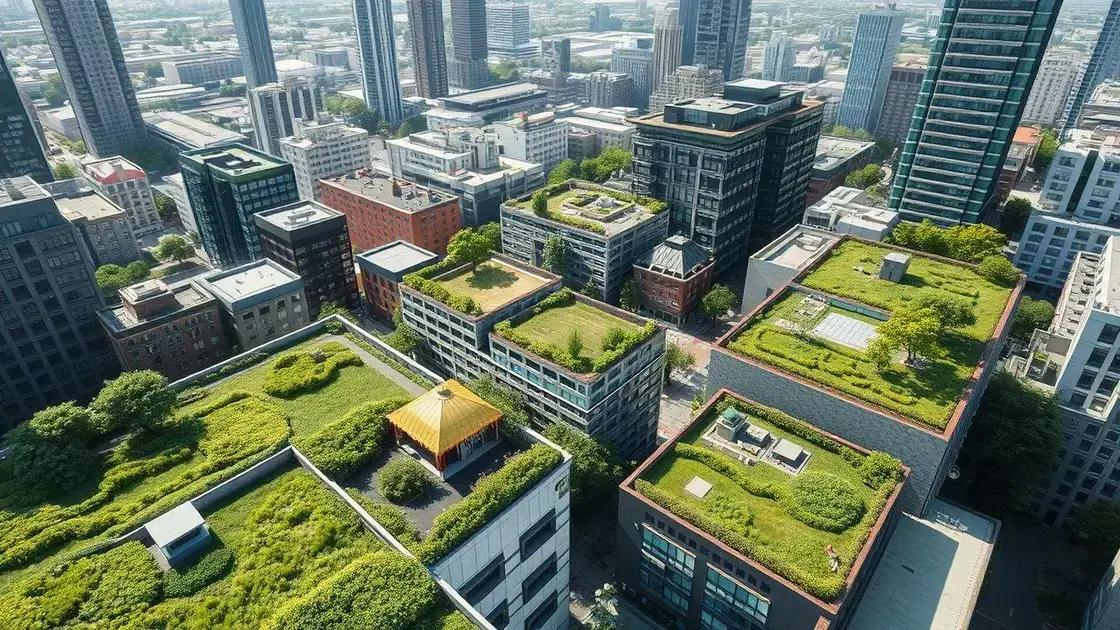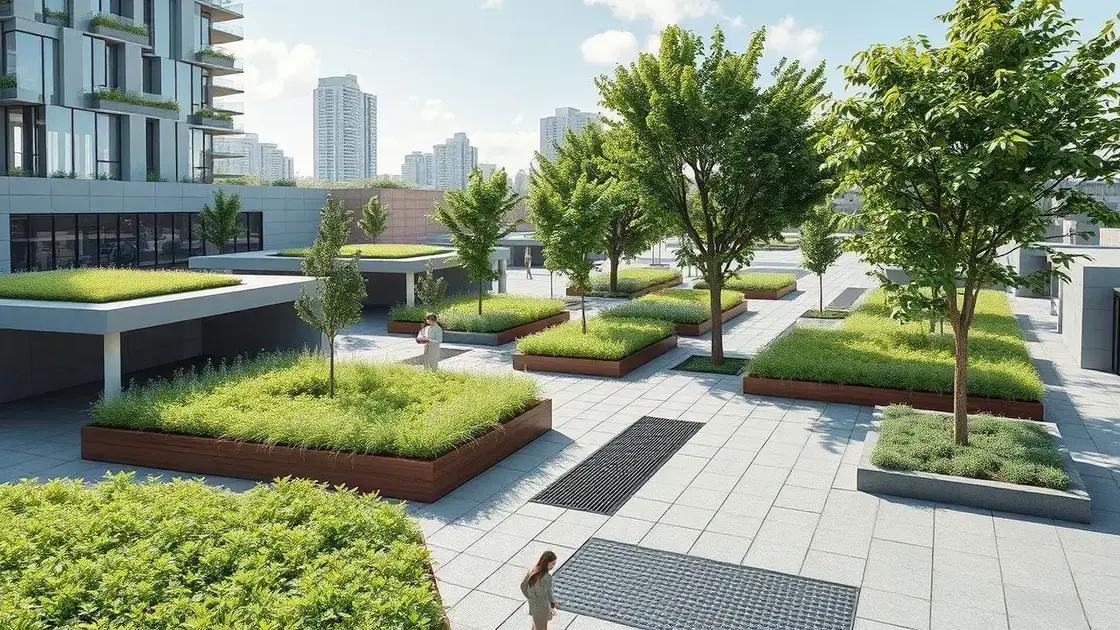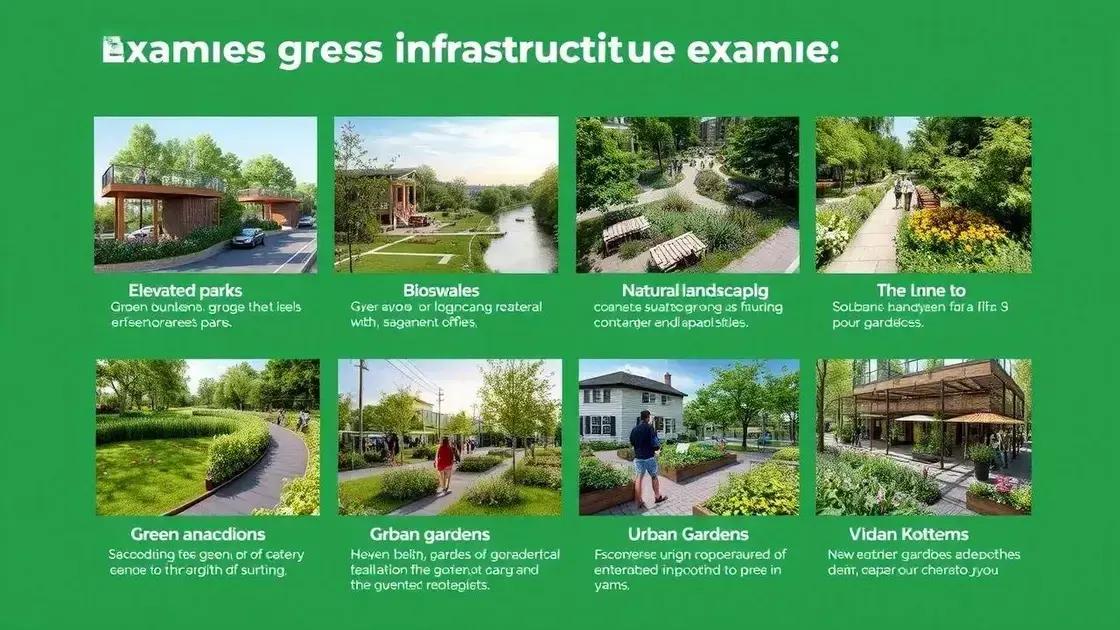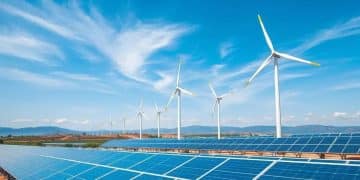Green infrastructure headlines trends shaping our cities

Green infrastructure utilizes natural processes to manage stormwater, improve air quality, enhance urban resilience, and create healthier, more sustainable cities.
Green infrastructure headlines trends are taking center stage in urban planning, enhancing the quality of life in cities around the world. Have you noticed how these innovations are reshaping our environments? Let’s explore how they contribute to sustainability and resilience.
Understanding green infrastructure
Understanding green infrastructure is essential for anyone looking to improve urban spaces. This concept uses natural processes to manage water and create healthier environments. It plays a significant role in making cities more resilient to climate change.
What is Green Infrastructure?
Green infrastructure consists of strategically placed green spaces, parks, and sustainable drainage systems. These features work together to reduce stormwater runoff and provide habitats for wildlife. By integrating nature into urban planning, we can promote biodiversity and improve air quality.
Benefits of Green Infrastructure
Implementing green infrastructure offers numerous benefits, including:
- Enhanced stormwater management
- Improved urban heat island mitigation
- Increased recreational spaces for communities
- Boosted property values
These advantages make it clear why cities worldwide are shifting towards greener solutions. By adopting practices like green roofs and permeable pavements, cities can reduce flooding risks and improve overall resilience.
Key Components of Green Infrastructure
Key components of effective green infrastructure include:
- Green roofs that absorb rainwater and provide thermal insulation
- Rain gardens that filter pollutants from stormwater
- Urban forests that increase shade and improve air quality
- Wetlands that capture and store floodwaters
As cities embrace these components, we see a transformation of urban landscapes. Communities benefit not only from the environmental impacts but also from the social and economic advantages. The integration of nature into our cities can enhance our quality of life while making them more sustainable for the future.
Challenges in Green Infrastructure
While the benefits are clear, challenges exist in implementing green infrastructure. Funding, maintenance, and community engagement are all crucial aspects that need addressing. Collaboration between government, private sectors, and communities is essential to overcome these hurdles.
Latest trends in green infrastructure

The latest trends in green infrastructure reflect a growing commitment to sustainable urban development. Cities worldwide are recognizing the need to integrate nature into their landscapes. By doing so, they enhance ecological health and improve residents’ quality of life.
Innovative Green Roofs
One trend that has gained traction is the adoption of green roofs. These roofs not only provide insulation but also absorb rainwater. They help to reduce heat in urban areas, making buildings more energy-efficient. Many cities are incentivizing the installation of green roofs through subsidies or tax breaks.
Permeable Pavements
Permeable pavements have also become popular. This type of surface allows water to pass through, reducing runoff and replenishing groundwater. They are especially useful in high-traffic areas, enabling cities to manage stormwater effectively.
In addition, cities are increasingly implementing bioswales and rain gardens. These features use vegetation to filter and manage stormwater, promoting a natural water cycle. As more communities embrace these practices, we see an overall improvement in urban resilience.
Urban Forestry Initiatives
Another significant trend is the rise of urban forestry initiatives. Planting trees in urban spaces helps combat the urban heat island effect. These initiatives also provide habitats for wildlife and enhance beauty in surroundings.
Community participation is crucial in these programs. Cities are engaging residents through tree planting events, which boosts community pride and awareness of the benefits of green infrastructure.
Smart Technologies in Green Infrastructure
Technology plays a vital role in the latest trends as well. Smart sensors are being integrated into green infrastructure systems for real-time monitoring. This enables cities to adjust their strategies based on weather patterns and precipitation levels, maximizing efficiency.
As these trends continue to evolve, we expect to see a transformation in urban landscapes. Communities will thrive, and environmental impacts will lessen. The focus on sustainability shows great promise for future city planning.
Benefits of implementing green infrastructure
Implementing green infrastructure offers numerous benefits that positively impact urban environments. These advantages enhance the quality of life for residents while also promoting sustainable practices. Let’s explore the key benefits of integrating green infrastructure into our cities.
Environmental Advantages
One major benefit is the environmental impact. Green infrastructure helps manage stormwater more effectively, reducing the risk of flooding. It utilizes natural systems to direct rainwater back into the ground, replenishing groundwater supplies. Additionally, these systems improve air quality by filtering pollutants and providing oxygen.
Economic Benefits
The economic advantages cannot be overlooked. Investing in green infrastructure can lead to lower energy costs. Features like green roofs improve insulation, reducing heating and cooling expenses. Furthermore, properties with green spaces tend to increase in value, making neighborhoods more attractive.
- Reduced energy costs
- Higher property values
- Attractiveness for new businesses
- Potential for job creation in green sectors
As cities develop these green features, they can stimulate local economies and promote business growth.
Social Benefits
Socially, green infrastructure contributes to healthier communities. Access to parks and green spaces encourages physical activity and enhances mental well-being. Such areas also foster social interactions, bringing people together and strengthening community bonds.
Additionally, children can benefit from increased exposure to nature, which can enhance their learning experiences and creativity. Connecting with green spaces makes urban living more enjoyable and fulfilling.
Resilience to Climate Change
Moreover, implementing green infrastructure increases a city’s resilience to climate change. It helps mitigate the effects of heat waves and heavy rainfall. By incorporating natural elements, cities can adapt better to extreme weather events, making them safer for residents.
Overall, the benefits of green infrastructure create a win-win situation for cities. Enhanced environmental health, economic prosperity, and improved social well-being are just a few reasons to advocate for greener urban landscapes.
Real-life examples of successful green infrastructure

Real-life examples of successful green infrastructure showcase how cities are transforming their environments. These projects demonstrate the effectiveness of integrating nature into urban settings, providing inspiration for others to follow.
New York City’s High Line
The High Line in New York City is a prime example. This elevated park was built on a former railway line, converting a space into lush greenery. It features walking paths, gardens, and seating areas, making it a popular destination for both residents and tourists. The High Line not only beautifies the area but also supports local ecosystems and reduces urban heat.
Portland’s Green Streets
Portland, Oregon, has implemented a green streets program that includes bioswales and permeable pavement. These features help manage stormwater runoff effectively. By incorporating plants and soils, Portland’s green streets filter pollutants before rainwater reaches rivers. This initiative is vital in protecting local waterways while enhancing the beauty of residential areas.
The Chicago Riverwalk
The Chicago Riverwalk is another excellent example of green infrastructure. This waterfront space incorporates natural landscaping and seating areas along the river. The project helps improve water quality and supports local wildlife. It also provides a recreational space for residents, promoting community engagement.
These examples highlight the many benefits of green infrastructure. Not only do they enhance aesthetics, but they also improve environmental health and foster community connections. Cities around the world can learn valuable lessons from these projects as they aim to implement their green initiatives.
Singapore’s Gardens by the Bay
Singapore’s Gardens by the Bay is a stunning example on an international scale. This site features iconic Supertrees, which are vertical gardens that support various plant species. The gardens utilize sustainable technology and practices, showcasing how urban spaces can thrive through eco-friendly designs. Visitors experience nature while learning about sustainability and conservation.
Together, these real-life examples of green infrastructure highlight innovative approaches to solving urban challenges. They inspire other cities to integrate nature into their development plans for a healthier future.
FAQ – Frequently Asked Questions about Green Infrastructure
What is green infrastructure?
Green infrastructure refers to a network of natural and semi-natural systems that manage stormwater, enhance biodiversity, and improve urban environments.
How does green infrastructure benefit cities?
Green infrastructure provides environmental benefits, boosts local economies, promotes social well-being, and increases resilience to climate change.
Can you provide examples of successful green infrastructure projects?
Yes, examples include New York City’s High Line, Portland’s green streets, and Chicago’s Riverwalk, all of which enhance urban areas and manage stormwater effectively.
How can I advocate for green infrastructure in my community?
You can advocate by raising awareness, organizing community events, and collaborating with local governments to support sustainable urban development initiatives.





